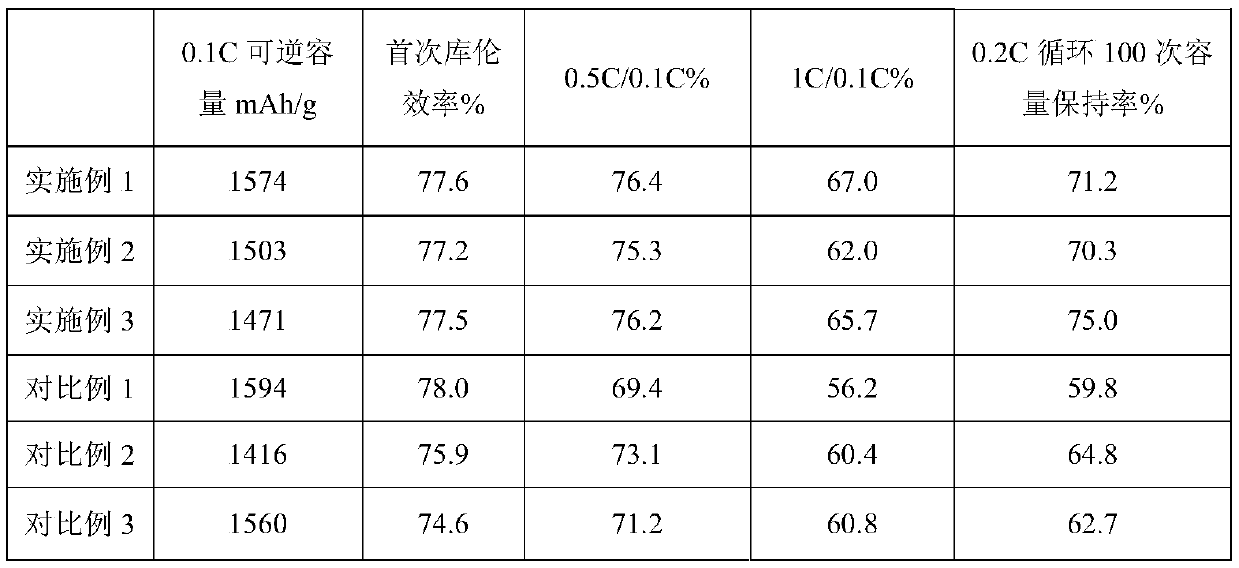Lithium-ion battery silicon monoxide negative electrode material, preparation method and application thereof
A lithium-ion battery, silicon oxide technology, applied in battery electrodes, negative electrodes, secondary batteries, etc., can solve problems such as difficulty in meeting high-rate charge and discharge performance, general rate performance of silicon oxide negative electrode materials, and low conductivity. , to achieve the effect of shortening migration distance, good cycle performance and excellent performance
- Summary
- Abstract
- Description
- Claims
- Application Information
AI Technical Summary
Problems solved by technology
Method used
Image
Examples
Embodiment 1
[0064] This embodiment provides a silicon oxide negative electrode material for a lithium ion battery, which is prepared by the following method.
[0065] (1) Fragmentation of silicon oxide:
[0066] 20 parts of silicon oxide (raw material particle size is 10 μm) and 0.5 parts of additive polyethylene glycol 1500 were mixed in absolute ethanol, and crushed to 300 nm by wet sanding process.
[0067] (2) Spray granulation of silicon oxide:
[0068] Add 1 part of conductive agent (SP: multi-walled carbon nanotubes = 1), 1 part of organic carbon source phenolic resin and an appropriate amount of solvent absolute ethanol to the crushed silicon oxide suspension to make a solid content of 25%. The spray slurry was sprayed and granulated on a closed-loop three-fluid spray dryer. The inlet temperature of the spray drying was 120°C, and the outlet temperature was 80°C to obtain spherical silicon oxide secondary particles with a particle size of 6.2 μm.
[0069] (3) Pyrolysis of silico...
Embodiment 2
[0075] This embodiment provides a silicon oxide negative electrode material for a lithium ion battery, which is prepared by the following method.
[0076] (1) Fragmentation of silicon oxide:
[0077] 20 parts of silicon oxide (raw material particle size is 5 μm) and 0.5 part of additive stearic acid were mixed in absolute ethanol, and crushed to 650 nm by wet planetary ball milling process.
[0078] (2) Spray granulation of silicon oxide:
[0079] Add 1 part of conductive agent (acetylene black: multi-walled carbon nanotubes = 1), 4 parts of organic carbon source sucrose and an appropriate amount of solvent deionized water to the broken silicon oxide suspension to make a solid content of 15%. The spray slurry was sprayed and granulated on a three-fluid spray dryer, wherein the inlet temperature of the spray drying was 160°C, and the outlet temperature was 90°C to obtain spherical silicon oxide secondary particles with a particle size of 4.9 μm.
[0080] (3) Pyrolysis of sili...
Embodiment 3
[0086] This embodiment provides a silicon oxide negative electrode material for a lithium ion battery, which is prepared by the following method.
[0087] (1) Fragmentation of silicon oxide:
[0088] Evenly mix 20 parts of silicon oxide (raw material particle size is 3 μm) and 2 parts of additive polyvinylpyrrolidone K30, and crush to 720 nm by dry planetary ball milling process.
[0089] (2) Spray granulation of silicon oxide:
[0090] In the solvent deionized water, add silicon oxide after crushing, 0.5 part of conductive agent (Ketjen black: thin-layer graphene=1), 8.5 parts of organic carbon source glucose, and make it into a spray slurry with a solid content of 20%. Spray granulation was carried out on a two-fluid spray dryer, wherein the inlet temperature of the spray drying was 180° C., and the outlet temperature was 102° C. to obtain spherical silicon oxide secondary particles with a particle size of 5.3 μm.
[0091] (3) Pyrolysis of silicon oxide:
[0092] Under ni...
PUM
| Property | Measurement | Unit |
|---|---|---|
| particle size | aaaaa | aaaaa |
| particle size | aaaaa | aaaaa |
| particle size | aaaaa | aaaaa |
Abstract
Description
Claims
Application Information
 Login to View More
Login to View More - R&D
- Intellectual Property
- Life Sciences
- Materials
- Tech Scout
- Unparalleled Data Quality
- Higher Quality Content
- 60% Fewer Hallucinations
Browse by: Latest US Patents, China's latest patents, Technical Efficacy Thesaurus, Application Domain, Technology Topic, Popular Technical Reports.
© 2025 PatSnap. All rights reserved.Legal|Privacy policy|Modern Slavery Act Transparency Statement|Sitemap|About US| Contact US: help@patsnap.com

